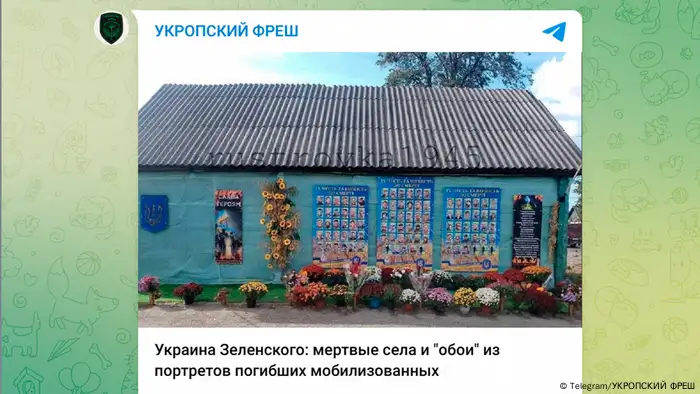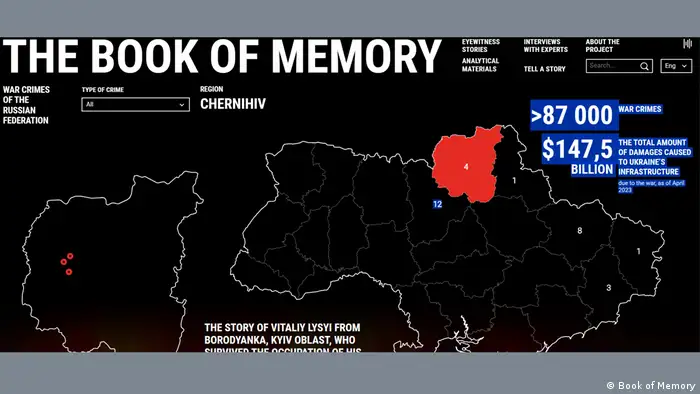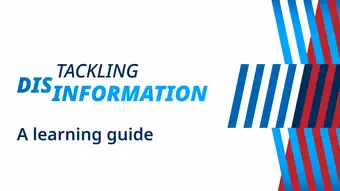Tackling disinformation: A learning guide
How Russian disinformation manipulates data on Ukraine war
The Ukrainian Media and Communication Institute explains how disinformation campaigns manipulate data and statistics in the context of Russia's war on Ukraine.
Diana Dutsyk is the founder and executive director of the Ukrainian Media and Communication Institute (UMCI), a non-governmental organization that tracks various areas where Russia strategically employs data in disinformation campaigns. Dutsyk shares her insights into Russian disinformation campaigns with DW Akademie.
DW Akademie: What do you mean by data manipulation in disinformation campaigns?
Diana Dutsyk: Data manipulation in disinformation campaigns can take various forms. This includes the alteration, falsification or exaggeration of statistics. In the context of Russia's war on Ukraine, Russia's disinformation campaigns rely heavily on distorting statistics, presenting false data or interpreting correct figures in a misleading way to promote its geopolitical agenda.
The manipulated data plays a key role in shaping narratives and influencing public opinion. Across various areas, from the perception of the army's performance on the battlefront, Ukraine's demographic situation or the situation of Ukrainian refugees abroad, statistics and data are often used in disinformation campaigns to fit Russia's agenda and serve its strategic aims.
Visual manipulation techniques are employed to present data in a manner that distorts their true meaning or misleads the audience. This could entail the creation of charts, graphs or images depicting fabricated data or presenting accurate data in a misleading way to deceive viewers. Legitimate data may be selectively represented visually to bolster a specific narrative, often by omitting crucial contextual details that would alter the interpretation of the information.
Another tactic involves the incorrect interpretation of data. Experts, politicians and other influential figures may contribute to data misinterpretation by interpreting statistics in a misleading way, for example by cherry-picking from data to support only certain arguments or by not providing sufficient context for the audiences to interpret data in its complexity. Even accurate statistics can be subjectively interpreted in a way that distorts reality, leading to cognitive distortions among the audience.
Why do you think it's important to research data manipulation?

Diana Dutsyk is the founder and executive director of the Ukrainian Media and Communication Institute
In today's digital age and with the multiplication of available data for the greater public, the manipulation of data has become an important and efficient tool in disinformation campaigns. Research shows that media content with data is often perceived as more reliable by audiences, so manipulating data has a potential for greater impact than media content without figures and statistics.
Data manipulation can lead to greater efficiency in disseminating disinformation, it can undermine the credibility of those media sources that use data and statistics responsibly and create an overall erosion of the audience's trust towards statistics and figures in general.
State actors strategically employ data manipulation to advance their interests and sow confusion. Particularly in the context of conflicts and wars, where state actors like Russia actively engage in propaganda efforts, it's important to understand how data manipulation works, and what impact it has on their audiences. That helps find strategies and approaches to tackle the issue.
Manipulation of data and statistics influences the perception of these data. Misleading representation of data can shape public opinion and influence societal mood, affecting the course of ongoing conflicts and wider geopolitical narratives.
Can you give some interesting examples from the context of Russia's war on Ukraine?
Our organization tracks various areas where Russia strategically employs data in disinformation campaigns. We conduct ongoing monitoring of Russia's disinformation efforts, scrutinizing an extensive range of media and social media sources to identify patterns, establish guidelines and devise strategies to effectively counteract disinformation.
In Russian propaganda, it is important to justify the war both internationally and domestically, which, two years on, they still officially call a "special military operation." One of Russia's central claims is that Ukraine is losing the war on the battlefront, the country is suffering enormous losses on all levels, the demographic situation is dire, and some territories of Ukraine are becoming empty land.
Although Ukraine in February 2024 announced for the first time some data about its losses, it is worth noting that it does not publish regular statistics on military losses, such as fatalities and injuries. It maintains that such information is sensitive to the war efforts and continues to keep such information classified. Consequently, there exists no means to fully and independently verify most of Russia's claims about Ukraine's losses.
But there are indications suggesting that Russia's statistics may be fabricated or exaggerated. Based on independent research efforts and according to Western intelligence estimates and experts, Russian authorities are manipulating its statistics on military losses, death tolls and figures on casualties in that it is diminishing its own losses and exaggerating Ukraine's.
One of the most striking examples was February 2023 when Russia, ahead of the one-year anniversary of the full-scale invasion, released figures on Ukraine's alleged colossal losses. It put the number of dead and wounded soldiers around 300,000 above Western estimates.
Another example isn't about these large, overall statistics, but rather how data is manipulated to tell the "story" of a specific village in Ukraine. This village was allegedly "emptied" of adult men, who were mobilized for the war with many of them dying on the front, the report alleged. To support this claim, a Telegram channel published reports showing a wall of a house completely covered with photos of dead soldiers. These allegedly all came from this one village and had all died. The report claimed that only a few "pensioners and administrative employees" were left in the settlement, which boasted around 500-600 people before the war.

One example of Russian data manipulation is when this Telegram channel falsely claimed that a Ukrainian village was "emptied" of adult men because of the war
Ukrainian fact-checkers quickly debunked these claims. They proved that the photo with dozens of dead soldiers wasn't made in the village but rather in a city, and the statistics used were for a whole "Hromada," a municipality with an estimated population of more than 37,000 people and not for the small settlement.
In contrast to other reports that used overall fabricated statistical figures on Ukraine's allegedly dramatically decreased population, which fact checkers could debunk, this story about the village's losses used an emotional and local perspective to support the same narrative.
Since the Israel-Gaza war started last October, Russia has also spread disinformation based on false data about Ukraine's alleged involvement in the conflict. An interesting example is when the campaign put out a video that cited reputable Western brands — the BBC and the open-source intelligence group Bellingcat — and used these sources to support the claim that Ukraine is delivering weapons to Hamas.
The second part of the campaign spread a fabricated screenshot of a report allegedly by the Washington Post newspaper, which claimed that weapons supply from Ukraine to Hamas had tripled. All these claims were fabricated as there was no such report by the Washington Post or the BBC, and Ukraine denied such allegations.
Another important goal of Russian propaganda is to downplay the importance of Western sanctions on its economy and lives of everyday Russians. Independent research shows examples that range from manipulating mortality causes to inflation and poverty rates, unemployment figures or even crime statistics.
What is the impact of these data manipulation efforts on the Ukrainian society and public debates about the war? What are its implications for Ukraine, the war?
Russia tailors its information and propaganda strategies in response to developments on the front lines and within the international and domestic political arena, so the impact of these campaigns is dynamic and particularly challenging to rigorously evaluate. A further complication is that the campaigns are disseminated on social media platforms, particularly messaging apps like Telegram: because of Ukraine's blockage of Russian official media, Russia relies heavily on pro-Russian Telegram channels for this purpose. As a result, proper research is lacking in this field.
What we know from experience is that figures on military losses and casualties evoke strong emotions among Ukrainians, so any such report affects people's mood and contributes to the changes in the country's political mood.
How could we better tackle data manipulation?
In 2022, the business magazine Forbes ranked data literacy as the second most crucial skill for the next decade after digital literacy. In my view, alongside bolstering general media literacy among Ukrainians, a focused emphasis on data literacy within educational programs is important.
There are different definitions of data literacy. In my view, the one that gives a comprehensive view defines data literacy as the combination of skills and mindsets that allows individuals to find insights and meaning within their data to enable effective, data-informed decision-making. The skills needed vary according to the goal. For ordinary users, this is the ability to read and analyze data and critically interpret it. For professional users, a larger set of skills is required, such as data visualization, data management (data collection, verification and storage) and others.
Journalists hold a crucial position in combating data manipulation and misinterpretation. Therefore, journalism faculties should incorporate dedicated courses on data literacy to address issues stemming from journalists' inadequate understanding of data, which often leads to dissemination of erroneous or misleading narratives.
Independent NGOs also play a pivotal role in countering data manipulation. In Ukraine, there are several good examples of this. One such initiative is the Kremlin's Voice, which catalogs Russian propagandists and their statements regarding Ukraine. Another is the Book of Memory, which documents Russia's war atrocities and crimes and the damages caused by Russia in Ukraine's civilian life, mixing personal accounts and stories with statistics.

The Book of Memory collects stories of witnesses and victims of Russian war crimes that occurred in Ukraine during Russia's war on Ukraine
Diana Dutsyk, PhD, has 27 years of professional experience in journalism and 20 years of lecturing experience in Mohyla School of Journalism at the National University of Kyiv Mohyla Academy. She is also a professional coach and has conducted numerous training courses for journalists, including on conflict-related topics. The Ukrainian Media and Communication Institute, which she heads, closely cooperates with DW Akademie on several projects.
This written interview was conducted by Attila Mong. It has been lightly edited for brevity and clarity.
This article is part of Tackling Disinformation: A Learning Guide produced by DW Akademie.
The Learning Guide includes explainers, videos and articles aimed at helping those already working in the field or directly impacted by the issues, such as media professionals, civil society actors, DW Akademie partners and experts.
It offers insights for evaluating media development activities and rethinking approaches to disinformation, alongside practical solutions and expert advice, with a focus on the Global South and Eastern Europe.
DW recommends
Audios and videos on the topic
- Date 14.04.2024
- Author Attila Mong
- Feedback: Send us your feedback.
- Print Print this page
- Permalink https://p.dw.com/p/4eYcc
- Date 14.04.2024
- Author Attila Mong
- Send us your feedback.
- Print Print this page
- Permalink https://p.dw.com/p/4eYcc



